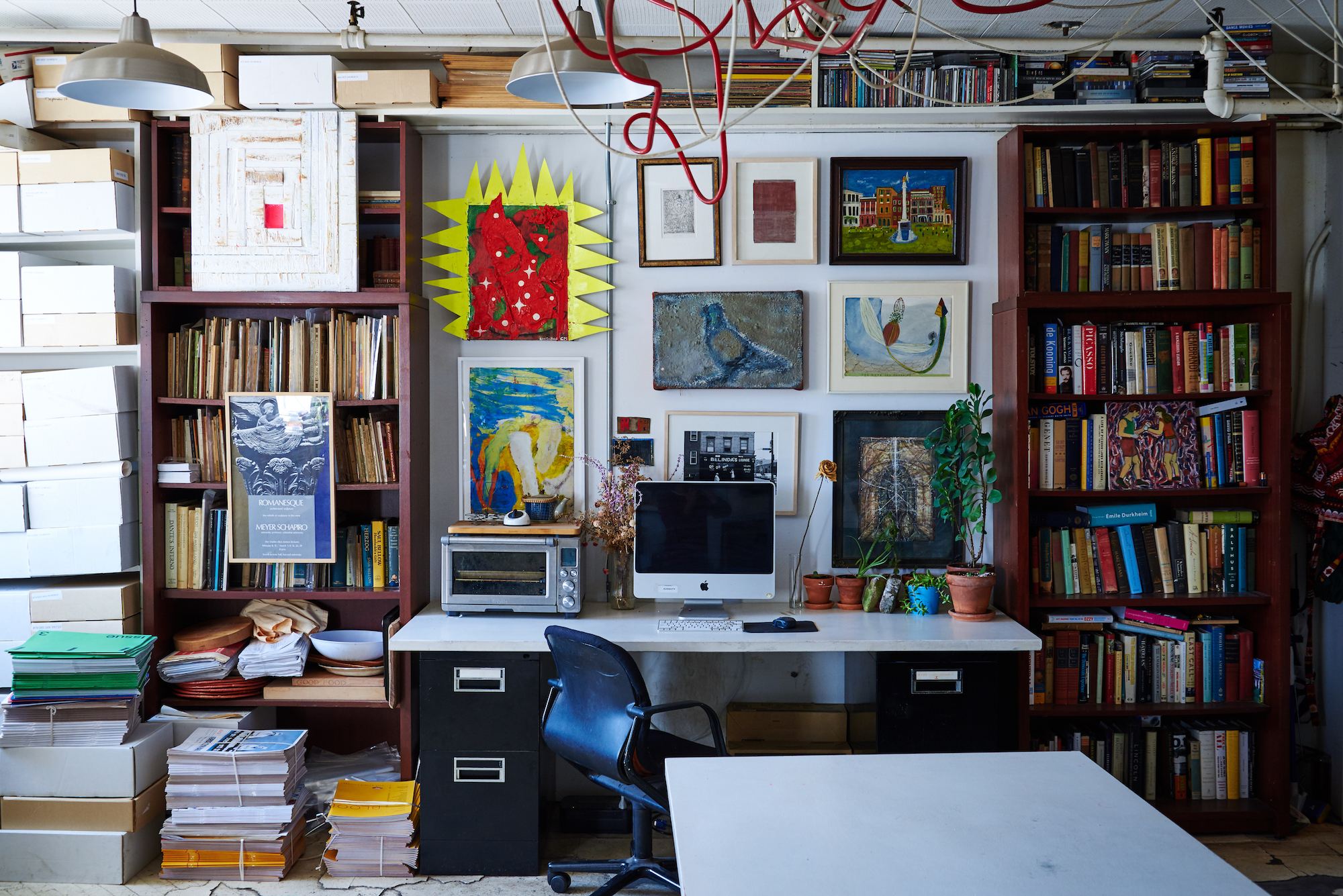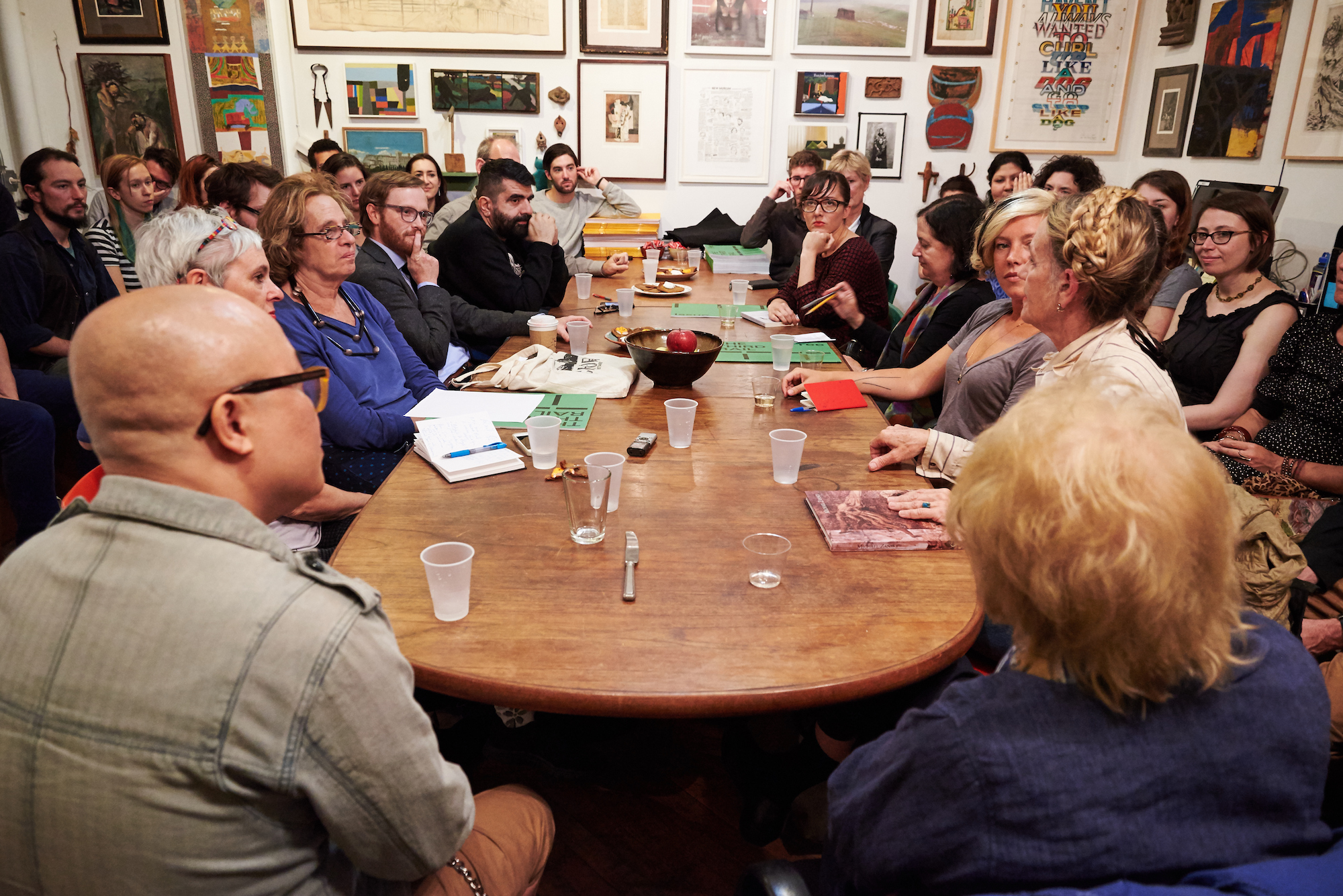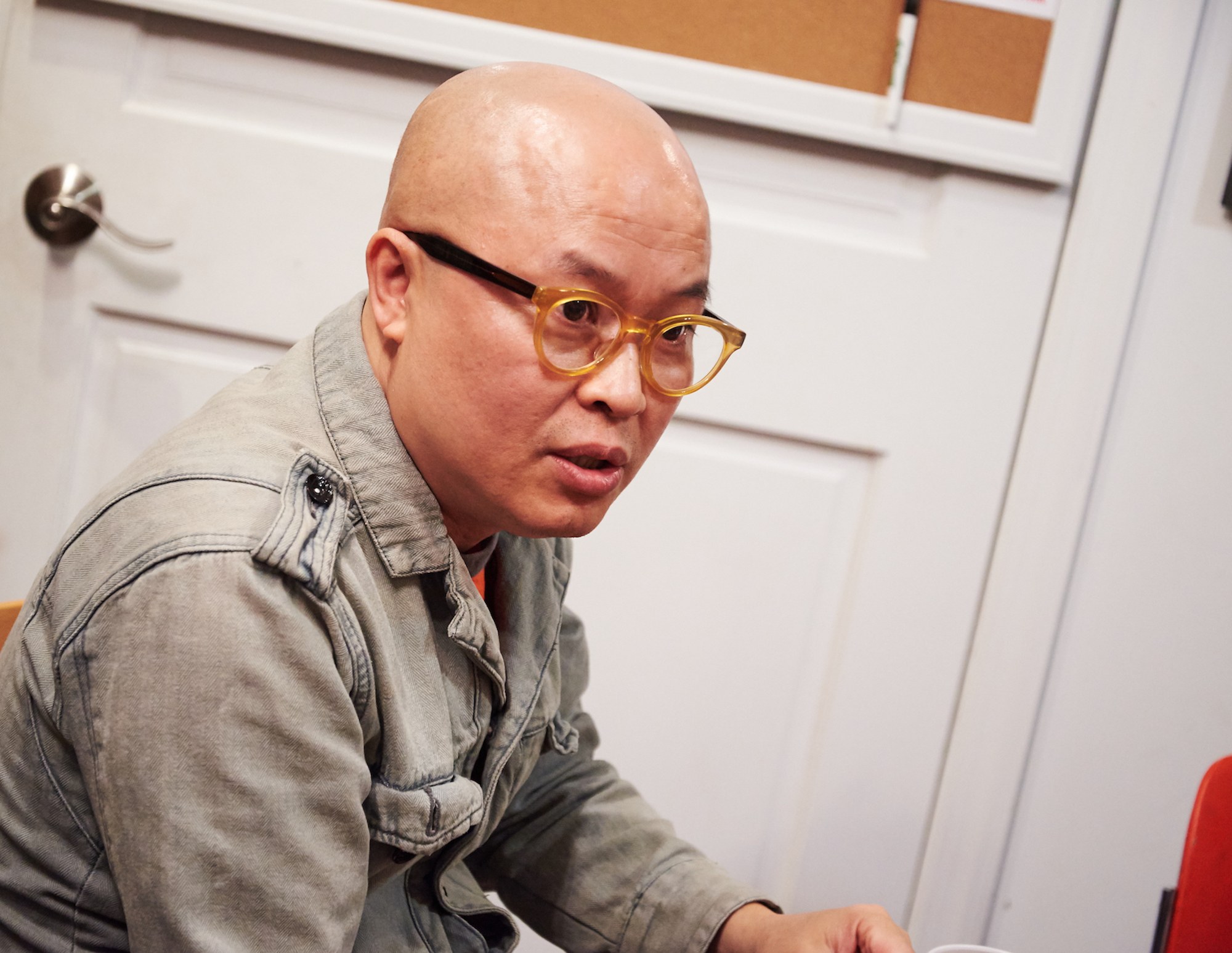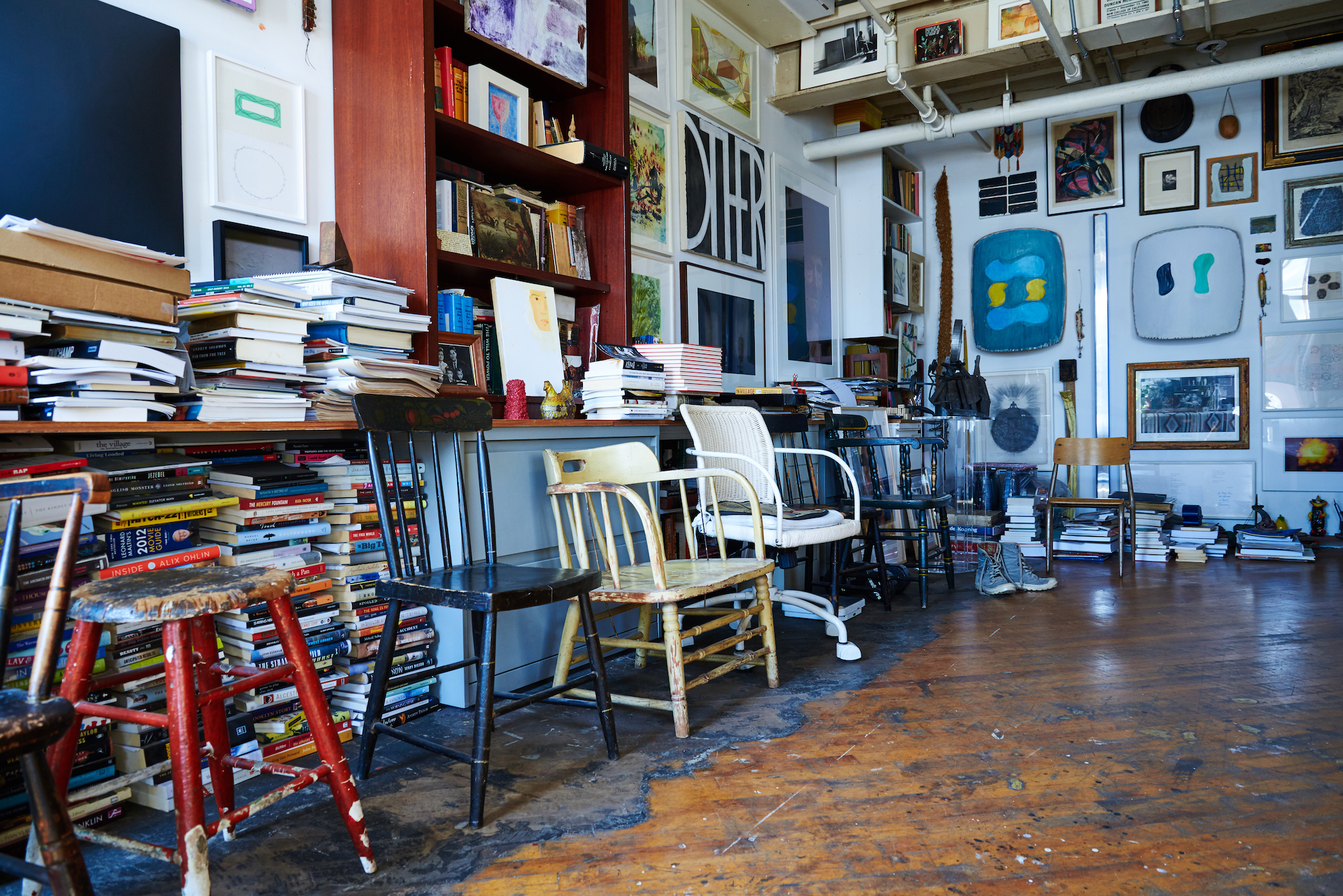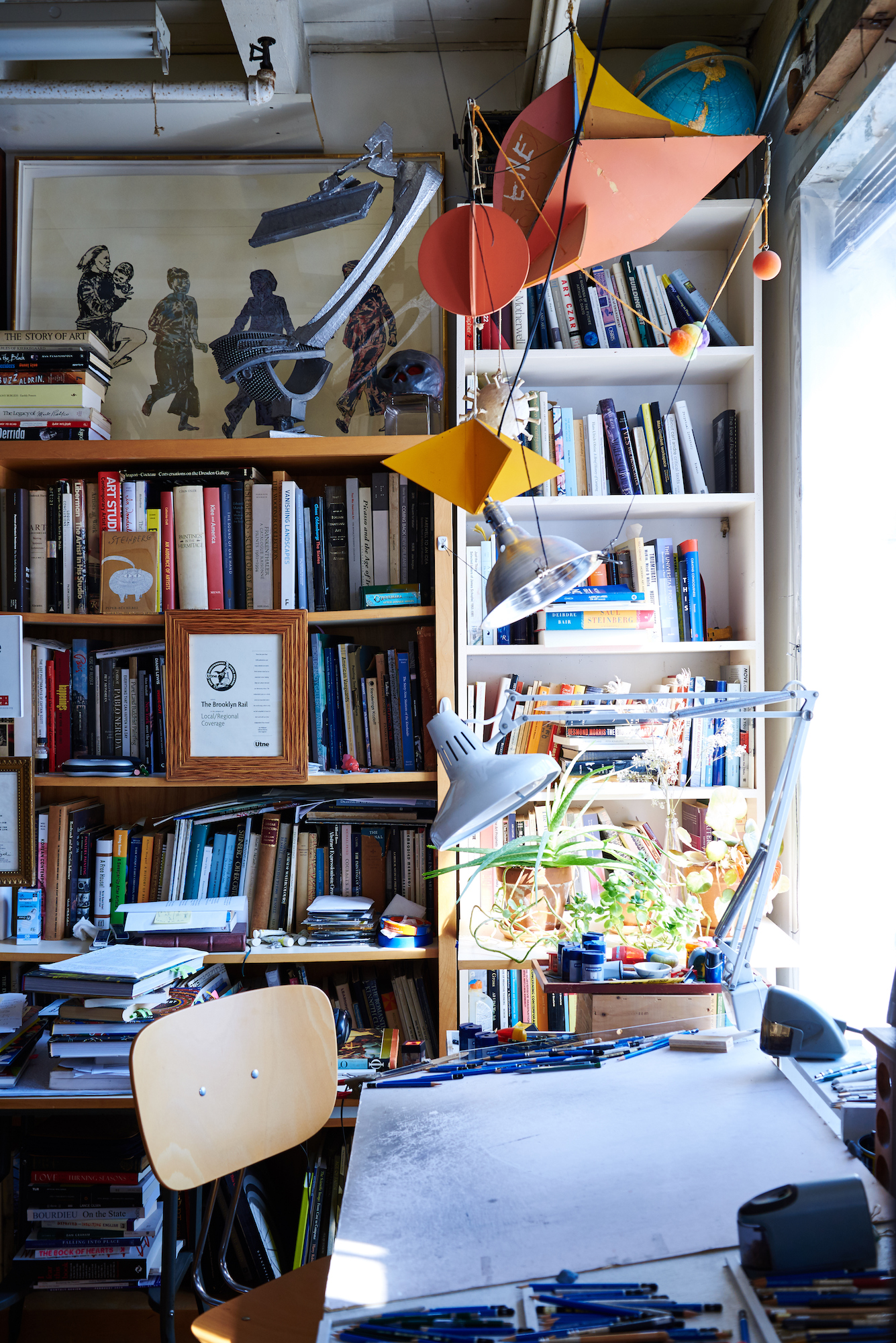Profile: Phong Bui
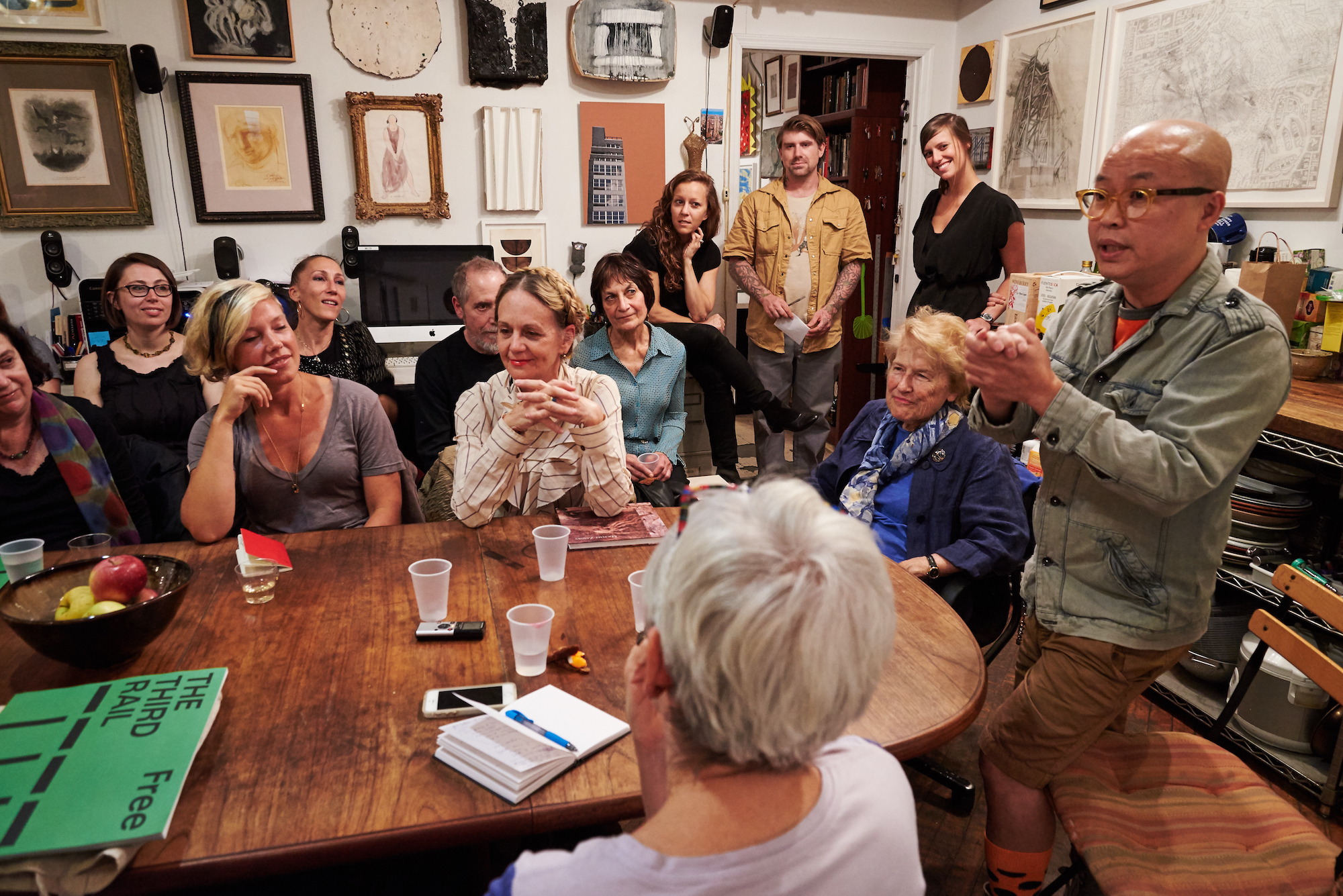
Phong Bui speaks to colleagues in the offices of The Brooklyn Rail [photos: Zack Garlitos]
Share:
This feature originally appeared in ART PAPERS November/December 2014.
“There’s a beautiful Vietnamese proverb that I was told by my beloved grandmother, who I regard as the most essential and important person who formed me, in addition to the Schapiros, Lillian and Meyer. She once told me that to live in a long tube, be thin; to live in a barrel, be round. So the ability to adapt is very important to one’s growth, one’s sanity. That process of adaptation takes you out of your own introspection because you’re constantly in the mode of action.”
—Phong Bui
Phong Bui is no stranger to adaptation. There was the first massive shift of gears, from his privileged life as son of an intellectual and businessman in the imperial city of Huê to a labor camp in rural Vietnam, then a second, from the labor camp to Bucks County, PA. Then Bui went from having reserved dreams of being a graphic designer (à la Alexander Liberman in Vogue), to having frenetic aspirations as a painter (à la de Kooning), to being a working student at the New York Studio School, to being an acolyte of Lillian and Meyer Schapiro. His last transition took him from the role of enthusiastic participant in, to that of publisher and editor-in-chief of the ever-expanding free monthly The Brooklyn Rail. Bui has transferred his beloved grandmother’s mantra beyond himself and conferred it on the Rail, an amorphous entity that encapsulates a publication, an ongoing curatorial project, and a printing house, now with editions catering not only to the big, fat, and round New York area, but to long and thin Miami, with Miami Rail, and, with The Third Rail, to Minneapolis and the surrounding Midwestern urban sprawl.
The greatest adaptive challenge in recent memory for Bui struck one night in late October 2012, when the waters of the Newtown Creek estuary surged through his Commercial Street studio, housed in the basement of the Rail’s Greenpoint headquarters. Bui had an opening that same night at Show Room gallery on the Lower East Side. Titled Work According to the Rail, Part 1, the exhibition presented a series of paintings that were overlaid onto old copies of the Rail, speaking to Bui’s dual roles as artist and editor, and perhaps, to his dual identities as an artist and editor, and perhaps, to his dual identities as an individual, and as the publication itself. The show went on, however: the opening was crowded despite the looming anxiety surrounding Hurricane Sandy that permeated the room and the city, where subways were shutting down at midnight and no one knew what to expect. Much of the Rail’s archives were destroyed that night, along with the bulk of Bui’s work. To many in the arts in New York it felt like the storm had specifically targeted studios and galleries, swamping all the low-lying coastal enclaves in the city that house areas of art production and commerce: Tribeca, Red Hook, Greenpoint, Gowanus, and of course, Chelsea and its galleries.
The offices of The Brooklyn Rail [photos: Zack Garlitos]
As vast quantities of art were destroyed or damaged, new and previously submerged ideas came to the surface in the disembodied atmosphere: the publication had been liberated from its archives, and an artist removed from his own history. At the suggestion of Jack Flam, head of Robert Motherwell’s Dedalus Foundation, a plan for a massive exhibition promoting the work of artists affected by the hurricane took shape. Bui saw the project not simply as a means of reclaiming some of the territory the artistic community lost to the natural disaster, but as a way to showcase the artistic production of the city—and, for two months at least, to act as director of the biggest temporary museum of local contemporary work that New York had ever seen. As the show expanded to involve “friends and family” of artists impacted by the storm, its roster ballooned to include more than 300 painters, sculptors, and video and performance artists. The resulting Come Together: Surviving Sandy was the ultimate, one-time New York biennial.
Since the 2011 departure of longtime editor John Yau, the Rail has entered a mode that Bui calls “Occupy Rail”—in which the publication has sought to expand, albeit organically, into other metropolitan areas, and into the sphere of the art gallery. Bui says, “It’s not an institution. It’s a form of independent benevolent anarchy, without being anarchistic.” Each geographical edition takes on its own, very different physical and philosophical form: in Miami under publisher Nina Johnson-Milewski, and in Minneapolis under editor/publisher Cameron Gainer. Following its inaugural Come Together, Rail Curatorial Projects has since given Chelsea audiences Bloodflames Revisited, which opened in July 2014 at Paul Kasmin Gallery, and Spaced Out: Migration to the Interior, Bui’s takeover of Red Bull Studios this fall. These expansive group exhibitions have espoused not so much a particular curatorial viewpoint as they have a desire to bring artists of all stripes into the same space under the broad banner of intellectual foment.
The Brooklyn Rail first appeared in 1998 as a photocopied broadsheet, intended to be read on the L-train by passengers commuting into Manhattan from the then-still-more-shabby-than-chic Williamsburg. Its four founding editors were Theodore Hamm, Joe Maggio, Christian Viveros-Fauné, and Patrick Walsh. Playwright and current theater editor Emily Devoti came up with the name. The team had already met Phong Bui during frequent visits to The Brooklyn Ale House, a late 1990s hangout that closed just this past summer, and he was involved from the start.
Phong Bui speaks to colleagues in the offices of The Brooklyn Rail [photos: Zack Garlitos]
Quick readability was the goal of the first flimsy Rail: its contents had to be digestible on the brief but crowded and often miserable L-train ride from Bedford Avenue and Lorimer Street in Brooklyn to Manhattan stations only two or three stops down the line. Still, neighborhood news and politics were as vital to these early editions as art theory and criticism were. The publication has bulked up to well in excess of a hundred pages since then but has retained its “Brooklyn” nature, if only in the location of its headquarters, and perhaps its left-leaning values and spunky resourcefulness, too. Local news has been eliminated in favor of an ever-increasing number of interviews, essays, reviews, and works of poetry and fiction. It has also become infused with the aspirations of its publisher and (now) editor-in-chief.
Bui was born in 1964 in Huê, Vietnam. His father worked as a history teacher before becoming a businessman, to better support his seven children. According to Bui, his extended family was “80% academic,” and very politically minded. Its members largely supported the expulsion of the French from the country, but were divided over what to do after that, and the subject was frequently discussed. Regardless of their political leanings, the Bui family was privileged. It had four live-in maids and two cooks until 1976, when it was evicted from its home and forced to put everything its members could fit into a single truck, and moved to a farm—a form of labor-based class re-education. “It was an experience that was fruitful for all of us,” Bui recalls philosophically, “because it was in the middle of the country in the delta area, where you were given a piece of land and you were expected to live off of it as a form of punishment. There was no electricity, no running water, you had to build your own house, learn how to farm.” The family farmed rice, grew oranges, and fished for sustenance.
In 1980 Bui and his family relocated to Bucks County, PA, where the first film they ever saw in America was, disturbingly, John Boorman’s 1972 Deliverance. Bui later attended the Philadelphia College of Art, where he excelled at graphic design. He wound up with a job offer from the Hallmark Company in Kansas City, but he didn’t take it, setting his sights instead on that career at Condé Nast. He landed an interview there, too; before the meeting, he wandered through the Museum of Modern Art alone for the first time. That’s where he happened upon Willem de Kooning’s Woman, 1 (1950–1952).
“It was a ferocious image. I was floored by the visceral movement of the abstract formation of the brushstroke. It mediated with an image—you know, the present image somehow was of the image itself, but [the image] didn’t have to conform to how abstract or naturalistic it should be. The kind of intense mediation really gave me the creeps—I got goose bumps.” Bui found a pay phone and called his professor, Jane Piper, back in Philadelphia, and she secured him a place at Mercedes Matter’s Studio School. For his first eight months there, Bui worked as a cook in the evening, and lived with extended family in Jersey City; eventually, though, he found it advantageous simply to sleep in his studio. After his first semester, he received enough of a scholarship to stop working and got more sleep.
It was a wide-eyed Bui who showed up at the door of Lillian and Meyer Schapiro’s small Greenwich Village townhouse, having been assigned to pick up a painting by the art historian for an exhibition of work by Studio School faculty. He had arrived promptly and said little, as advised. Schapiro quizzed him on his background, and finding that he was from Huê, conferred with his wife and invited him in for tea. At the end of the visit, Schapiro lent Bui his copy of the first volume of Soren Kierkegaard’s Either/Or and told him to come back in two weeks at the same time. In his own personal version of Columbia University’s “great books” curriculum, Bui would borrow, read, and discuss a different classic every week or two. He and Schapiro remained close friends until the latter’s death in 1996, at age 91. The scholar’s Marxist art historical method and discourse on style still resonate with the Rail editor’s outlook and oeuvre. Looking for some direction in a mid-1980s New York art scene preoccupied by AIDS, Jean-Michel Basquiat, Julian Schnabel, and Keith Haring, Phong Bui found Meyer Schapiro.
Schapiro’s work can be found on the walls of the current Brooklyn Rail offices, which are crammed, salon style, with small framed drawings, texts, photographs, and canvases—including an unsigned Philip Guston, a Rackstraw Downs drawing, and several tribal-looking Ron Gorchov and Chris Martin pieces, all immediately recognizable. Schapiro’s are less so; only upon interrogation will the visitor be informed that the abstractions providing the colorful backdrop to the Rail’s long editorial discussions are his.
The offices of The Brooklyn Rail [photos: Zack Garlitos]
As a curator, Bui was welcomed into the “all-hands-on-deck” atmosphere of Alanna Heiss’ PS1 Contemporary Art Center, where he worked as an advisor, 2007–2010, and organized a 2008 presentation of the Brooklyn collective Minus Space. His radio show, “Off The Rails,” began streaming on WPS1 Radio (now part of Heiss’ Clocktower Productions), serving to expand upon interviews printed in the Rail. Bui’s curatorial work for Come Together is further evidence of his multiplatform philosophy. The show aligned the often-contradictory forces of the city itself and the “art world” that inhabits it, drawing together real estate interests, established galleries, and well-known and emerging artists in a sometimes uneasy harmony. Bui is adept at giving all parties a bit of what they need in order to broker a momentary syzygy of agendas and aesthetics. With Blood Flames Revisited, he reenacted the roles of both Frederick Kiesler and Nicolas Calas, surrealists in exile who mounted the original Bloodflames 1947 at New York’s famed Hugo Gallery The reimagining was, as Bui notes, “an experiment in furthering the thinking and dialogue about the representation of works.” The artists assembled at Paul Kasmin included Not Vital, Candida Höfer, Roxy Paine, Lynda Benglis, Glen Ligon, Michael Joo, and 19 others; the space featured an intricate, bespoke stage set of Bui’s own making (a cross between the Merzbau and an Ed Wood movie set, much like Kiesler’s original), and an accompanying catalogue was produced, as well as a program of poetry readings and performance.
With such activities, a surreal inversion has taken place, as the history book has become the blueprint for the contemporary scene, though no one appears to have noticed yet. Its trail blazed entertainingly (and unpredictably) under the influence not only of Schapiro, but of authors as historically and conceptually disparate as Giorgio Vasari and Selden Rodman, the Rail has historically tended to take an adversarial position with regard to the greater art world, promoting a less commercial, even painting-oriented philosophy. Since the publication took form at the turn of the century, New York has seen the commercialization and subsequent intellectual disintegration of its primary alternative (and Manhattan-centric) free weekly, the Village Voice (and the 2011 disappearance of its never-quite-embraced competitor, New York Press). The Rail has sought actively to fill the void. “I’m a cosmopolitan, sensitive New Yorker,” quips Bui, but the Rail’s robust online presence and now international readership has steadily steered its editorial focus from its bitter perch at a former periphery to a perhaps more centrist position—and its voice from that of a commentator to one of an arbiter, a keeper of an ever-increasing volume of artists’ own words and thoughts. As a collaborative workspace, a publication, a curatorial entity, a promotional machine, and a master of ceremonies, the Rail is a hyperlocal nexus in an expanding region that the most established artists in America, and the aspiring new guard, still call home.
Will Corwin is a sculptor based in New York City. His public project The Great Richmond, a collaboration with urban planner Neil Greenberg, went on view at the Staten Island Ferry Terminal, St. George, in September, 2014.
